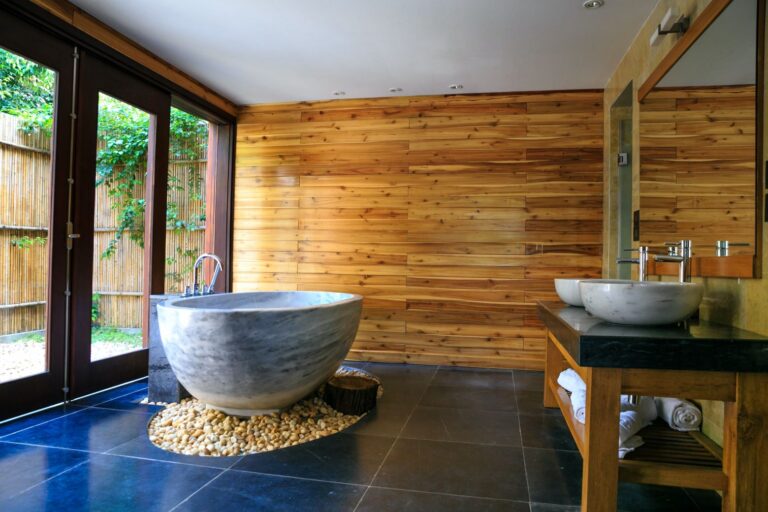In an increasingly urbanized world, the need for a deeper connection to nature is becoming more apparent than ever before. Biophilic design, a concept that integrates natural elements into the built environment, is rapidly gaining popularity as a way to bridge the gap between our indoor and outdoor worlds. This innovative approach to design not only enhances the aesthetics of our living spaces but also offers a myriad of physical and psychological benefits. In this article, we will explore the fascinating world of biophilic design and how you can incorporate it into your home.
Table of Contents
What Is Biophilic Design?
Biophilic design is a design philosophy that seeks to bring nature into our interior spaces. The term “biophilia” was first coined by biologist Edward O. Wilson, who proposed that humans have an innate affinity for nature and a deep-seated need to connect with it. Biophilic design leverages this natural inclination by incorporating elements of the natural world into architecture, interior design, and urban planning.
The Core Principles of Biophilic Design
- Natural Light: Maximizing the use of natural light is a fundamental principle of biophilic design. Large windows, skylights, and open floor plans allow daylight to flood your living spaces, creating a connection to the outdoors and reducing reliance on artificial lighting.
- Indoor Plants: Incorporating living plants into your interior decor is one of the most direct ways to embrace biophilic design. Plants not only purify the air but also bring life and vitality to your home. Consider adding potted plants, hanging gardens, or even a living wall.
- Natural Materials: Choosing natural and sustainable materials, such as wood, stone, and bamboo, can significantly enhance the biophilic aspect of your space. These materials provide tactile and visual connections to nature, giving your home an organic and welcoming feel.
- Nature-Inspired Patterns: Incorporating patterns and motifs inspired by nature, such as floral prints or patterns resembling tree bark, can evoke a sense of being outdoors. These designs can be applied to wallpapers, textiles, and even furniture.
- Water Features: The sound and sight of water have a calming effect on the human psyche. Incorporating water features like fountains or indoor ponds can introduce a soothing, natural element into your living space.
Benefits of Biophilic Design
- Improved Well-Being: Studies have shown that exposure to nature, even in the form of biophilic elements, can reduce stress, increase productivity, and improve overall well-being.
- Enhanced Creativity: Biophilic design can stimulate creativity and problem-solving abilities, making it an excellent choice for workspaces and creative studios.
- Better Air Quality: Indoor plants not only add beauty to your home but also help purify the air by removing toxins and increasing oxygen levels.
- Connection to Nature: Biophilic design fosters a sense of connectedness to the natural world, even in urban environments, which can improve mental health and reduce feelings of isolation.
- Sustainable Living: Many biophilic design principles align with sustainability goals, making it a responsible choice for eco-conscious homeowners.
Incorporating Biophilic Design into Your Home
To embrace biophilic design in your home, start by assessing your living space and identifying areas where you can introduce natural elements. Here are some practical ideas:
- Indoor Gardens: Create a mini indoor garden with potted plants and hanging planters. Consider the varying light and humidity requirements of different plants to ensure their health.
- Natural Materials: Choose furniture and decor made from natural materials like wood, stone, or rattan. Opt for sustainable, eco-friendly options when possible.
- Natural Light: Maximize natural light by removing heavy curtains or blinds and opting for sheer or light-filtering window treatments. Use mirrors strategically to reflect and amplify natural light.
- Water Features: If space allows, add a small tabletop fountain, a fish tank, or a wall-mounted water feature to introduce the soothing sound of water into your home.
- Nature-Inspired Art: Incorporate art and decorations that feature nature-inspired patterns, colors, or imagery.
Conclusion
Biophilic design is a transformative approach to interior design that allows us to reconnect with the natural world in our daily lives. By incorporating elements like natural light, indoor plants, natural materials, and water features, you can create a harmonious and inviting living space that nurtures your well-being and brings the beauty of the outdoors inside. Whether you’re looking to refresh your home or design a new space, consider embracing biophilic design and experience the many benefits it has to offer.





